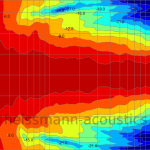^Felt and towels can have some effect but is very little / tricky to adjust and a marketing tool at best.
Only way to get rid of edge diffraction related secondary sound source is to get rid of the edge. Well, another possibility to exploit is to not radiate sound toward that edge on wavelengths where its acoustically big. Few ways to get rid of a loudspeaker edge:
1. really get rid of it, roundover with radius big enough to wavelength, basically sphere whose radius much bigger than the transducer radius (otherwise there is an edge between transducer and the sphere).
2. get the edge far enough from the transducers so that path length to the edge is similar to path length to room boundaries, edge becomes one with the room and effectively disappears.
3. get the edge so close to the transducer there is no delay to the edge and it becomes one with the transducer and effectively disappears.
Felt just introduces another edge so the material should be chosen carefully to be effective for the wavelengths etc, then it tries to reduce sound toward the box edge which it isn't usually effective enough for practical amount of it that fits on the space so all that happened was some spreading of the "problem". Basically its not very good solution. Its better to roundover the edges with big enough radius, basically one needs to approach a sphere, as big radius as fits. If you are lazy, make the box/structure no bigger than the transducer and no roundover fits and performance is pretty good. Use low pass filter below diffraction happens. For tweeter one can't use low pass, so use big enough round over.
Remember, commercial speakers need to be visually appealing, also people usually want visually appealing stuff.
Speaker that has low diffraction is probably not very appealing, or cheap, or easy to DIY. Its much easier to make rectangular box, have it vaneered nice and populated with trendy components and sell it to customer with nice margin.




